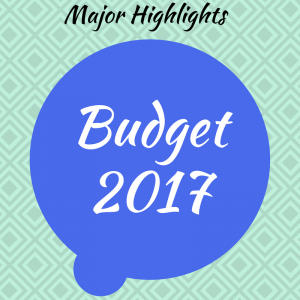Budget 2017 has been presented by the Finance Minister Mr.Arun Jaitley on Wednesday,1st February 2017.
Here we shall discuss the key highlights of this year’s budget : Union Budget 2017-18 that you must know.
Every year when the budget is set to be rolled out, this arises curiosity amongst various sectors and individual taxpayers as well. All hoping to see some new policies,reforms and benefits that have a positive impact.
No matter, you are a salaried person, a small trader, a businessman,industrialist running a company or a common man.You might be eager to know what’s in store for you this time in the Budget 2017 especially after the recent demonetisation drive.
So,here we bring for you the exclusive details on Budget 2017, Highlights of Budget 2017 and how far budget 2017 meets your expectations.
Budget 2017 has 10 distinct themes and important reforms for :
- Farmers
- Rural population
- Youth
- The poor
- Infrastructure
- Financial sector
- Digital economy
- Delivery of public service
- Prudent fiscal management
- Tax administration that honours the honest
Different measures and reforms have been introduced for the benefit of different sectors in the country.
FM defined the Budget agenda as Transform,Energise and Clean India -TEC India.
Budget 2017 Highlights you must know :
We have compiled some of the major highlights of Budget 2017 for the fiscal year 2017-18 that you might be interested to know about.These changes will be applicable for financial year that will commence on 1.4.2017 i.e. Financial year 2017-18.
For Individual tax payers :
- For financial year 2017-18 the Income Tax slab rate has been reduced to 5% for individuals having income between Rs 2.5 lakhs to Rs 5 lakhs. This Income tax slab rate was 10% for the financial year 2016-17. The remaining tax slabs remain as before.
So,you will be straightaway saving income tax of Rs.12500 (250000*5/100) + Education cess Rs.250 & Higher education cess of Rs.125 .
- For Financial year 2017-18 the rebate under section 87A has been reduced to Rs.2500 for individuals having income upto Rs.3.5 lakhs. For financial year 2016-17 this Rebate under section 87A was Rs.5000 for individuals with income upto Rs.5 lakhs. This is to avoid duplication of tax benefits.
The combined effect of the above two points shall mean that if your annual income is up to Rs 3 lakhs then your tax liability shall be nil.This is to avoid duplication of benefits for the Rs 2.5-5 lakhs tax slab.
If you are a senior citizen your income upto Rs.3 lakhs is anyways not taxable (as in F.Y.2016-17).
So,if your annual income is Rs.3 lakhs ( non senior citizen) : then Rs.2.5 lakhs is basic exemption as per tax slabs.Your tax shall be Rs.2500 ( 300000-250000)*5% .Now, you can claim rebate under 87A of Rs.2500. So,your final tax liability shall be NIL.
- A surcharge of 10% on individual income above Rs.50 lakhs and upto Rs.1 crore.
- A surcharge @ 15% on income above Rs.1 crore to continue as before.
We can sum up the above changes as shown in the Income tax rates table below.
Income tax slabs for Financial year 2017-18
| Annual Income | Income tax rate | Education cess | Higher education cess |
|---|---|---|---|
| Basic exemption: Income upto Rs.2.5 lakhs *For Senior citizens (60 years and above) Income upto Rs.3 lakhs *For Super senior citizens (above 80 years) Income upto Rs.5 lakhs | NIL | NIL | NIL |
| Rs.2.5 lakhs to Rs.3 lakhs | 5% | 2% | 1% |
| Rs.3 lakhs to Rs.5 lakhs | 5% | 2% | 1% |
| Rs.5 lakhs to Rs.10 lakhs | 20% | 2% | 1% |
| Above Rs.10 lakhs upto Rs.50 lakhs | 30% | 2% | 1% |
| Above Rs.50 lakhs upto Rs.1 crores | 30% + Surcharge of 10% | ||
| Above Rs.1 crores | 30% + Surcharge of 15% |
- A single one-page form for filing the Income Tax returns for people with taxable income up to Rs.5 lakhs other than business income.
- No change in limits of Tax deduction under Section 80C or other deductions. Huge expectations were there for an increase in the limit under section 80C.But,the maximum limit of investment to claim Tax deduction under section 80C remains Rs.1.5 lakhs only.
For Corporates :
- The corporate tax rate for MSME has been cut to 25%. In simple words, the income tax for small companies with an annual turnover of Rs.50 crores has been reduced to 25% from the earlier rate of 30%.
- Government has also relaxed conditions for the tax-exempted start-ups.These startups shall be allowed to carry forward losses even after original promoters reduce their holding to below 51%.
- Further,the profit-linked deduction available to the start-ups that was for 3 years out of 5 years has been changed to 3 years out of 7 years.
- There is no relief for the larger corporates. The time limit for claiming the MAT credit has been increased from the existing period of 10 years to 15 years.
For political parties :
- A political party can receive donation in cash upto a maximum of Rs.2000 only from one source.This measure is to encourage a clean political funding system.
- Political parties shall be entitled to receive donations by cheque or in digital mode from the donors.
- An amendment shall be made in RBI act for issuance of electoral bonds.These bonds could be purchased through cheque or digital mode.
Capital Gains :
- The period of holding for long-term capital gains tax on immovable property reduced from 3 years to 2 years.
- The base year indexation for calculation of capital gain tax has been shifted from 1.4.1981 to 1.4.2001.
Other :
- No transaction above Rs 3 lakhs in cash will be allowed. This a major reform to promote cashless transactions and a step ahead towards digital India.
- The limit of cash donations by charitable trusts has been lowered from Rs.10000 to Rs.2000 only.
- Service charge on e-tickets booked through IRCTC has been withdrawn.So,you can avail cheaper rail tickets if the booking is done online on the IRCTC website.
-
The duty on various Point-of-sale (POS) machines and iris readers has been exempted to encourage digital payments.
-
The basic customs duty on Liquefied Natural Gas or LNG has been be reduced from 5 % to 2.5 %.
-
Solar tempered glass used for manufacturing of solar cells/panels has been exempted from Customs Duty.
- Excise duty on Pan masala,tobacco,cigarettes and cigars raised.
- Duty on aluminium ores and concentrates raised to 30%.
- Foreign Investment Promotion Board (FIMP) to be abolished.
- Greater emphasis on converting India into a digital economy.
So,these are few of the main highlights of Budget 2017 that will impact you as a common man in one way or another.
There were huge expectations from Budget 2017 especially after the recent phase of demonetisation.The Government believes that demonetisation shall have a transient impact on the Indian economy and this bold measure shall lead to higher GDP growth.
The budget has a mixed response all over. Some have welcomed the various reforms while some feel they could have got more from it.
The overall budget focuses on making India as a bright spot in the world of economic landscape. Let us hope it has a long term positive impact on the Indian economy.
What are your views on the Budget 2017 ? Has this budget for the financial year 2017-18 met your expectations being a common man ? Feel free to share your valuable feedback in the comment section below !
Thinking to plan your investments, do checkout our popular blog post 7 Best Long term Investments in India


Thank you, my utmost gratitude for the effort of your team. I am indeed a regular visitor to your site. You provide a lot of useful information.